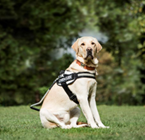Tips for interacting with Service Animals
(From the ADA Requirements: Service Animals)
How is “Service Animal” defined?
The ADA defines Service Animals as dogs individually trained to do work or perform tasks for people with disabilities. Examples of such work or tasks include guiding people who are blind, alerting people who are deaf, pulling a wheelchair, alerting and protecting a person who is having a seizure, reminding a person with mental illness to take prescribed medications, calming a person with Post Traumatic Stress Disorder (PTSD) during an anxiety attack, or performing other duties. Service animals are working animals, not pets. The work or task a dog has been trained to provide must be directly related to the person’s disability. Dogs whose sole function is to provide comfort or emotional support do not qualify as service animals under the ADA.
Where are Service Animals allowed?
Under the ADA, State and local governments, businesses, and nonprofit organizations that serve the public generally must allow service animals to accompany people with disabilities in all areas of the facility where the public is allowed to go. For example, in a hospital, excluding a service animal from areas such as patient rooms, clinics, cafeterias, or examination rooms would be inappropriate. However, excluding a service animal from operating rooms or burn units where the animal’s presence may compromise a sterile environment may be appropriate. It is appropriate to take the service animal in an ambulance as long as the animal is under control.
What questions to ask to determine if a dog is a Service Animal
- Is the dog a service animal required because of a disability?
- What work or tasks has the dog been trained to perform?
You are not allowed to:
- Request any documentation that the dog is registered, licensed, or certified as a service animal
- Require that the dog demonstrate its task, or inquire about the nature of the person’s disability
Because service animals are not required to wear vests, a dog that is wearing a vest is not necessarily a service animal. The dog still needs to be trained to perform a task for a person with a disability to be a service animal.
Further Resources:
ADA Requirements: Service Animals https://www.ada.gov/resources/service-animals-2010-requirements/
Frequently Asked Questions about Service Animals and the ADA https://www.ada.gov/resources/service-animals-faqs/
"This project is supported by the Health Resources and Services Administration (HRSA), Maternal and Child Health Bureau (MCHB), Emergency Medical Services for Children (EMSC) State Partnership grant program, Grant No. 2 H33MC066
98-18-00 for $190,650. This information or content and conclusions are those of the author and should not be construed as the official position or policy of, nor should any endorsements be inferred by HRSA, HHS or the U.S. Government.”

